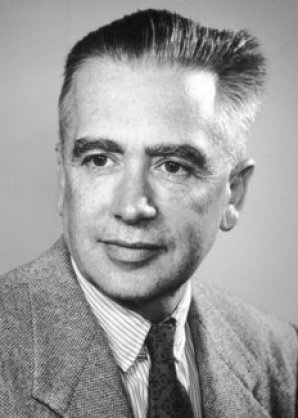Italy: Emilio Segre
1st February 1905 – 22nd April 1989

Emilio Segre was born near Rome, Italy. After studying at the University of Rome he became one of the group of young scientists led by Enrico Fermi and contributed to the discovery of slow neutrons. Later he was part of The Manhattan Project in the USA measuring the reactivity of fission products and studying isotope enrichment. After the war he started searching for antiprotons, the discovery of which he was awarded the 1959 Nobel prize for with Owen Chamberlain.
But another area of his work he is slightly less well-known for is his discovery of the element Technetium in 1937. On a visit to the USA, he persuaded the inventor of the cyclotron, Ernest Lawrence, to give him some Molybdenum foil that had been part of a cyclotron and had become radioactive. Segre and his colleague Carlo Perrier managed to prove that the radiation was from an unknown element; later named Technetium from the Greek word for artificial as it was the first element to be man-made. Segre then went on to isolate the metastable isotope Technetium-99 (Tc-99m)– now very important for nuclear medicine.
Technetium-99m is used as a radioactive tracer in 80% of all diagnostic procedures in nuclear medicine worldwide. The metastable state emits gamma radiation with a low energy of 140keV as the atoms relax to their stable state. This treatment therefore only exposes patients to minimum radiation doses. It is primarily used for brain, cardiac and bone imaging using gamma cameras that rotate around the body being diagnosed and can detect the gamma radiation being released from the radioactive material inside. It is also extremely useful for detecting hard-to-find cancers.
Although Tc-99m’s short 6 hour half-life makes it perfect for diagnostic treatment, it does make it almost impossible to transport to where it is needed. Instead, neutron reactors like the FRM II in Garching, Germany make Molybdenum-99 by bombarding Uranium-235 with neutrons. This isotope has a half-life of 66 hours providing extra transportation time to hospitals and medical centres, where Tc-99m can then be made in Technetium-99 generators in preparation for treatment procedures.
Unfortunately, issues with important existing Molybdenum-99 producing facilities mean that we are facing a worldwide Mo-99 (and therefore Tc-99m) shortage until supplies can be topped up by other facilities. But without Emilio Segre we would not have had Technetium in the first place. Little did he know that when he received a little bit of foil from America, it would lead to the saving of so many lives!
Back to The Road to the ESS
Other articles: Enrico Fermi




